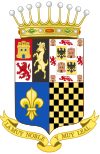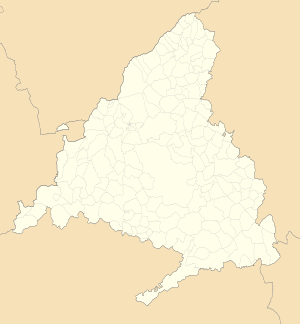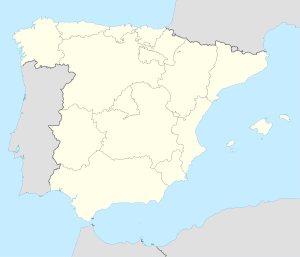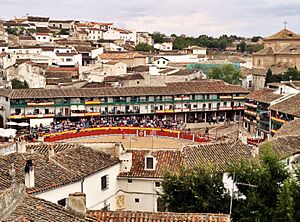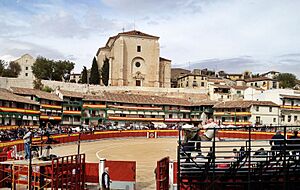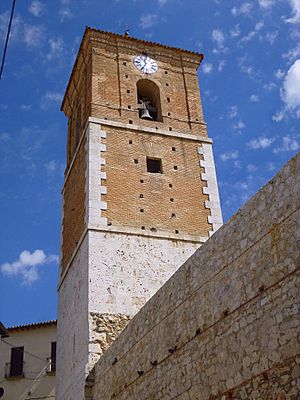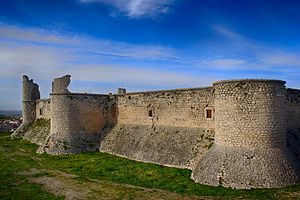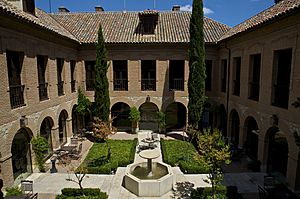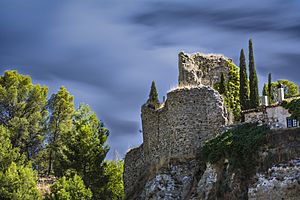Chinchón facts for kids
Quick facts for kids
Chinchón
|
|||||||||||||||
|---|---|---|---|---|---|---|---|---|---|---|---|---|---|---|---|
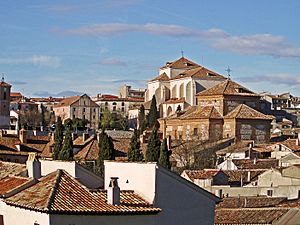 |
|||||||||||||||
|
|||||||||||||||
| Country | Spain | ||||||||||||||
| Region | Community of Madrid | ||||||||||||||
| Area | |||||||||||||||
| • Total | 115.91 km2 (44.75 sq mi) | ||||||||||||||
| Elevation | 753 m (2,470 ft) | ||||||||||||||
| Population
(2018)
|
|||||||||||||||
| • Total | 5,239 | ||||||||||||||
| • Density | 45.199/km2 (117.065/sq mi) | ||||||||||||||
| Demonym(s) | Chinchonete /-a | ||||||||||||||
| Time zone | UTC+1 (CET) | ||||||||||||||
| • Summer (DST) | UTC+2 (CEST) | ||||||||||||||
| Postal code |
28370
|
||||||||||||||
|
|||||||||||||||
Chinchón is a charming town and municipality in the Community of Madrid, Spain. It's about 50 kilometers (31 miles) southeast of the big city of Madrid. The town covers an area of about 116 square kilometers. In 2018, its population was 5,239 people. Chinchón is famous for its historic center, especially its amazing main square. This area was named a Heritage Site in 1974, meaning it's a very important historical place.
Contents
Exploring Chinchón's Historic Sites
Chinchón has many old and interesting buildings. These places tell stories about the town's long history.
The Famous Plaza Mayor
Chinchón's Plaza Mayor is a fantastic example of traditional Spanish architecture. The first houses with arches and balconies were built here in the 1400s. The square was completely enclosed in the 1600s.
It has a unique, irregular shape. The buildings around it have three floors. They feature wooden balconies called claros, supported by wooden pillars. There are 234 of these balconies in total!
Over the centuries, the Plaza Mayor has been a busy place. It has hosted royal parties, theater shows, and even bullfights. It was also used for important religious and military events. The square has even been a film set, like for the bullfighting scene in the movie Around the World in Eighty Days.
In 1992, people voted on whether to paint the square blue again, as it was in the 1600s. But the people of Chinchón chose to keep it green, the color they had always known.
Church of Our Lady of the Assumption
Building this church started in 1534. It was first planned as a chapel next to the Count's palace. Work stopped for 48 years! It was finally finished in 1626. The Counts of Chinchón agreed to pay for it with three conditions. They wanted a special view during mass and their family crests on the church. Also, all counts were to be buried under the altar.
In 1808, French soldiers set the church on fire. It was rebuilt 20 years later. The church today mixes different styles. These include Gothic, Plateresque, Renaissance, and Baroque. Inside, you can see a famous painting by Francisco de Goya. It's called the Assumption of the Virgin and was painted around 1812. Goya's brother, who was a chaplain for the counts, asked him to paint it.
The Old Clock Tower
This tower was once part of an older church called Nuestra Señora de Gracia. That church was built before the 1400s. French troops destroyed the church in 1808. Now, where the church stood, there is a small garden called El Mirador (the lookout). This garden is built on top of the old church's ruins.
The tower and its bells are still used today. They ring for religious events and to mark the passing of neighbors. Since 1755, it has also had a clock. It still chimes every hour and half-hour.
Castle of the Counts
The castle was first built in the late 1400s. But it was destroyed during a conflict in 1520. The 3rd Count of Chinchón, Diego Fernández de Cabrera, rebuilt it in the mid-1500s. It looks like a Renaissance castle. It's strong and wide, designed to protect against enemy attacks. Its sloped walls made it hard for attackers to climb.
The castle was left empty in the 1700s. It was badly damaged during the War of the Spanish Succession and again in 1808 by French troops. In the 1900s, it was used as a liquor factory. It has also been a set for many movies.
Convent of San Agustín (Now a Hotel)
This old convent is now a beautiful hotel called the Parador of Chinchón. It was rebuilt and restored in 1982. The town council gave it to the Spanish government. The first convent for Augustinian monks was founded here in the late 1400s. The current building was built around 1626.
During the 1700s and 1800s, it was a school. Students learned about theology, grammar, and Latin. Later, it became a court and a prison. Today, the hotel uses most of the old convent buildings. The church part is now a small chapel.
Convent of the Poor Clares
This convent was founded in 1653. It shows features of Spanish Baroque style. The building is simple, made with brick and stone. Inside, in the church choir, is a marble tomb for the V Counts of Chinchón. The convent was restored in 1995.
Castillo de Casasola
This castle is from the 1400s and is now in ruins. It has a triangular shape and is near the Tajuña river. It has a stone bridge and several towers. In the 1800s, it was used by politicians and soldiers. It is built in the Gothic style and is now owned by a private family.
Chinchón's Long History
Chinchón has a very old history, going back thousands of years!
Early Life and the Town's Beginning
The area around the Tajuña river has been home to people since the Stone Age. Many ancient remains have been found in caves. Around 600 BC, Iberian villages and burial sites were formed.
During Roman times, farming became very organized. You can still see parts of their old roads and irrigation systems. The Romans controlled the area from a nearby military base. This led to many small settlements growing in the valley.
For over 350 years, Chinchón was part of Islamic Spain, called Al-Andalus. The town of Chinchón itself was founded around the year 1000. It was a small fortress on a ridge. Some parts of the old walls can still be seen today.
In 1139, Alphonse VII took Chinchón for his Christian Kingdom of Castile. At first, it was a smaller part of Segovia.
From a Small Place to a County Capital
In 1480, Chinchón was given to the Marquises of Moya, Andrés de Cabrera and Beatriz de Bobadilla. They were close to the King Ferdinand and Queen Isabella. They built a castle and a palace. The royal family visited them often, which helped the town grow.
In 1520, Chinchón became a County. This brought more money and development to the town. Many of the large buildings you see today were built in the next 100 years. The main church was finished as part of the Count's Palace. The castle was rebuilt after being damaged. A new monastery was also built.
In 1629, the Counts became leaders in Peru. This brought more important people to Chinchón. Many families with Italian and Flemish names, like Dusmet, came during this time. While they were in Peru, a cure for malaria was found. It came from the bark of a tree. This tree was named Chinchona to honor the Countess. She supposedly used it to get better from malaria.
In 1706, Chinchón was involved in the War of the Spanish Succession. King Phillip V visited the town. The people of Chinchón showed their loyalty to him. Five months later, the opposing army attacked and looted the town. Phillip V won the war. He thanked Chinchón by giving it the motto "The very Noble and Very Loyal." He also helped pay for the town's rebuilding.
Difficult Times and Rebuilding
In 1808, during the Napoleonic conflicts, French troops attacked Chinchón again. They looted the town and destroyed the main church. Only its tower remained. The palace was also mostly destroyed. The castle was badly damaged. The Counts had already moved away from Chinchón. This destruction seemed like a big problem for the town's future.
But in 1845, something new happened. All the local wine, vinegar, and alcohol makers formed a group called Sociedad de Cosecheros. This group was very successful. They won awards at big world fairs in 1889 and 1900. They even became suppliers to the Queen!
This group started many public projects. They built water fountains and improved public lighting and sewage systems. They also helped pay for a railway to Madrid. This railway ran until the 1960s. The society also restored the main square. They completed some buildings and made it a formal arena. They also built the Theatre where the old palace used to be. This brought new life to Chinchón. In 1916, King Alphonse XIII declared Chinchón a city. This was because of its growth in farming and culture.
In 1974, Chinchón was named a Heritage Site. This means there are rules to protect its old buildings and traditions. Today, Chinchón is listed as one of "The Most Beautiful Towns in Spain." It's the only town in the Community of Madrid on that list!
Chinchón in the Movies
Chinchón has been a popular spot for filmmakers since the 1950s. The Internet Movie Database lists 32 movies that mention Chinchón as a filming location.
Early Films and Famous Directors
One of the first big movies filmed here was the French-Spanish film La belle de Cadix in 1953. Chinchón was used to look like a village in southern Spain.
Two years later, in Michael Anderson's Around the World in Eighty Days, the main square was used for a funny bullfight scene. Most of the people from Chinchón acted as the audience!
In 1961, about 7,000 local people were hired as extras for the movie King of Kings. This scene, directed by Nicholas Ray, was filmed on the rocky hills around Chinchón.
In Henry Hathaway's Circus World (1963), the Wild West scenes were filmed in Chinchón.
Orson Welles' Time in Chinchón
The famous director Orson Welles first came to Chinchón in 1965. He filmed scenes for his movie Chimes at Midnight here. He liked the town so much that he rented a house and lived there for long periods. The next year, he started filming The Immortal Story in Chinchón. He used Chinchón to look like old Macau, a city in Asia.
Spanish Cinema and More Recent Films
Many Spanish filmmakers have also chosen Chinchón for their movies. These include Carlos Saura's Deprisa deprisa, Pedro Almodovar's Matador, and Alejandro Amenabar's While at War.
In May 2021, it was announced that director Wes Anderson started building a huge set in Chinchón. A large film crew spent several months there to make his movie, Asteroid City.
Images for kids
See also
 In Spanish: Chinchón para niños
In Spanish: Chinchón para niños



